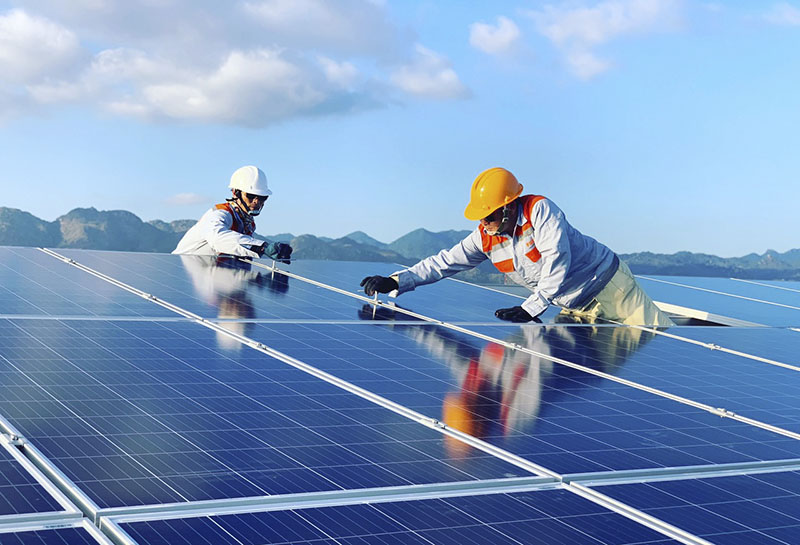According to the Ministry of Industry and Trade, the revised Power Plan VII was approved in the Prime Minister's Decision No. 428/QD-TTg dated March 18, 2016 and additional decisions to the revised Power Plan VII until the end of 2020. The total capacity of power sources put into operation in the 2016-2030 period is 109,090 MW/482 projects, of which 35,470 MW in the 2016-2020 period; 45,030 MW in period 2021-2025; 28,590 MW in period 2026-2030.
 Ensuring the progress of power sources under construction is very important for the security of electricity supply in the period 2021-2025
Ensuring the progress of power sources under construction is very important for the security of electricity supply in the period 2021-2025An update on the deployment of power source construction in the 2016-2020 period by the Ministry of Industry and Trade shows that the total capacity put into operation in the 2016-2020 period is only 28,377 MW out of the total capacity of 35,283 MW (including many renewable energy projects newly added and put into operation in 2019 and 2020). However, the total capacity of large power sources (coal, gas) put into operation in this period was low, only about 63%, so it led to a shortage of power sources, especially in the North recently.
Meanwhile, the balance of supply and demand in the Central and Southern regions, which is currently redundant, tends to become more redundant when the additional installed capacity increases in the Central and Southern regions in the period 2021-2030. This phenomenon leads to a sharp increase in the amount of transmission capacity in the North region compared to 2020, causing an overload on the North-South 500kV transmission power system, especially the Da Nang - Vung Ang and Vung Ang - Ha Tinh - Nho Quan sections.
Accelerating the improvement of power sources that are being deployed
Given the above difficulties, the review of Power Planning VIII of the Ministry of Industry and Trade is to arrange power sources on the view of ensuring the highest ability to self-balance within the region, avoiding long-distance transmission; make the most of the existing transmission capacity and do not build more inter-regional transmission lines in the period of 2021-2030; limit the construction of new inter-regional power transmission lines in the period 2031-2045.
From the inspection results of the Ministry, it is clear that ensuring the progress of the power sources under construction is very important for ensuring the security of power supply in the 2021-2025 period. The fact shows that coal or gas power projects, if started in the near future, will be difficult to operate in the period 2021-2025 because normally coal or gas power projects after being started will need a long time, about 4-5 years to complete.
According to Mr. Tran Viet Ngai, Chairman of the Vietnam Energy Association, the challenge posed to the risk of electricity shortage in the country in the coming years is present, especially because many projects are behind schedule from the adjusted Master Plan VII. Therefore, if the power sources under construction meet the set schedule, the power system will basically meet the load demand in 2021 and 2022. However, there is still the risk that the system will not be able to provide electricity in the years 2023-2025 for reasons such as:
Firstly, because the load may sharply increase due to abnormal climate conditions or the economy recovers strongly after the Covid-19 pandemic while the current power system reserve is quite low.
Secondly, the climate continues to change unpredictably, leading to an unfavorable hydrological situation, affecting the output of hydroelectric power plants, which contribute more than 30% of the total electricity output of the whole system; some gas power plants in the South have reduced output because gas fields are in the process of decline and exhaustion;
Thirdly, some large power projects still have potential risks of delay due to capital difficulties, risks of ensuring imported fuel sources due to complicated geopolitical issues in the world...
According to a preliminary assessment of the Ministry of Industry and Trade, if the large power sources under construction continue to be behind schedule, the highest level of power shortage may reach 10.8 billion kWh in 2025. Therefore, according to experts, it is necessary to have solutions to proactively ensure electricity supply in the 2021-2025 period, such as ensuring the progress of thermal power sources, increasing electricity imports from China and Laos, and continuing to encourage the development of renewable energy (especially on-site power sources), well exploiting the current capacity of the power system, making reasonable operation plans, ensuring that power sources are always highly available …
Ha Tran









 Webinar 2: “Financial Support for Energy Efficiency Enterprises – Opportunities and Challenges”
Webinar 2: “Financial Support for Energy Efficiency Enterprises – Opportunities and Challenges”
 Vietnamese enterprises achieve green growth and cut costs through energy efficiency
Vietnamese enterprises achieve green growth and cut costs through energy efficiency
 Capacity building for participating financial institutions in Ho Chi Minh City
Capacity building for participating financial institutions in Ho Chi Minh City
 Strengthening capacity for energy management officers of local government agencies
Strengthening capacity for energy management officers of local government agencies
 Strengthening Sales and Marketing Capacity for Energy Efficiency Equipment and Solution Suppliers
Strengthening Sales and Marketing Capacity for Energy Efficiency Equipment and Solution Suppliers
 Steel Enterprises Saving Energy and Enhancing Competitiveness
Steel Enterprises Saving Energy and Enhancing Competitiveness
 Capacity Building for Energy Officers of Government Agencies in the Central region
Capacity Building for Energy Officers of Government Agencies in the Central region